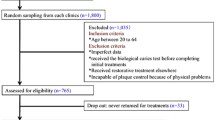Summary
Aim: To investigate in a group of children (n=183) the predictive value of early colonization of salivary lactobacilli and candida on caries development in primary molars and permanent first molars in 7 years of follow-up time by applying a longitudinal survival analysis method. Study design: Longitudinal cohort study of clinical outcomes based on dental records. Methods: The Kaplan-Meier survival analysis method was used to compare survival times to caries onset in primary molars and permanent first molars for children colonized by salivary lactobacilli and candida and children who were not colonized by those microbes at baseline when children’s mean age was 2.5 years. The survival time was the time elapsing between the birth of a child and the first restoration as a result of dental caries, that is the time when caries has progressed to a stage when a dentist has made a decision to restore the affected tooth. Results: The survival curves for primary and permanent molars were consistently lower for those children whose mouths were colonized by salivary lactobacilli at baseline. A statistically significant relationship was found with onset of caries in both primary and permanent molars and colonization by salivary lactobacilli. The survival of primary second molars was 60% at the age of 9 years in the group colonized by lactobacilli and 80% in those children whose mouths were not colonized. Colonization by candida was also a significant risk factor for caries onset in primary molars but not in permanent first molars. Conclusion: Children whose mouths were colonized by salivary lactobacilli at baseline were more susceptible to caries onset in both primary and permanent molars at any given time during follow-up of seven years than children who were not colonized by those caries associated microorganisms.
Similar content being viewed by others
References
Alaluusua S, Savolainen J, Tuompo H, Grönroos L: Slide-scoring method for estimation of Streptococcus mutans levels in saliva. Scan J Dent Res 1984;92:127–133.
Alaluusua S: Salivary counts of mutans streptococci and lactobacilli and past caries experience in caries prediction. Caries Res 1993;27(suppl 1):68–71.
Ansai T, Tahara A, Ikeda M, et al. Influence of colonization with mutans streptococci on caries risk in Japanese preschool children: 24 month survival analysis. Pediatr Dent 2000;22:377–380.
Clark HC, Curzon ME.: A prospective comparison between findings from a clinical examination and results of bitewing and panoramic radiographs for dental caries diagnosis in children. Eur J Paediatric Dent 2004;5:203–9.
Clarke JK: On the bacterial factor in the aetiology of dental caries. Br J Exp Pathol 1924;5:141–147.
Collet D. Modelling survival data in medical research. 1st edn. London, Chapman & Hall, 1994.
Gabre P, Martinsson T, Gahnberg L: Simplified sampling methods for estimating levels of lactobacilli in saliva in dental practice. Acta Odontol Scand 1999;57:181–184.
Glass RL: The lack of relationship between salivary lactobacillus counts and dental caries activity. Oral Surg Oral Med 1952;5:210–213.
Hadley FP: A quantitative method for estimating Bacillus acidophilus in saliva. J Dent Res 1933;13:415–428.
Hannigan A: Using survival methodologies in demonstrating caries efficacy. J Dent Res 2004;83 Spec Iss C:99–102.
Hausen H, Kärkkäinen S, Seppä L: Caries data collected from public health records compared with data based on examinations by trained examiners. Caries Res 2001;35:360–5.
Härkänen T, Larmas MA, Virtanen JI, Arjas E: Applying modern survival analysis methods to longitudinal dental caries studies. J Dent Res 2002;81:144–148.
Jensen B, Bratthall D: A new method for the estimation of mutans streptococci in human saliva. J Dent Res 1989;68:468–471.
Kopycka-Kdzierawski DT, Billings RJ: A longitudinal study of caries onset in initially caries-free children and baseline salivary mutans streptococci levels: a Kaplan-Meier survival analysis. Community Dent Oral Epidemiol 2004;32:201–209.
Larmas M: A new dip-slide method for the counting of salivary lactobacilli. Proc Finn Dent Soc 1975;71:103–110.
Larmas M: Saliva and dental caries: diagnostic tests for normal dental practice. Int Dent J 1992;42:199–208.
Larmas MA, Virtanen JL, Bloigu RS: Timing of first restorations in permanent teeth: a new system for oral heath determination. J Dent 1995;23:347–352.
Mjör IA, Gordan VV, Abu-Hanna A, Gilbert GH: Research in general dental practice. Acta Odontol Scand 2005;63:1–9.
Niederman R, Leitch J: “Know what ” and “know how”: knowledge creation in clinical practice. J Dent Res 2006;85:296–297.
Ollila P, Niemelä M, Uhari M, Larmas M: Risk Factors for colonzation of salivary lactobacilli and candida in children. Acta Odontol Scand 1997;55:9–13.
Ollila P, Larmas M: A seven-year survival analysis of caries onset in primary second molars and permanent first molars in different caries risk groups determined at age of two years. Acta Odontol Scand 2007;65:29–35.
van Palenstein-Helderman WH, Mikx FH, van’t Hof MA, Truin G, Kalsbeek H: The value of salivary bacterial counts as a supplement to past caries experience as caries predictor in children. Eur J Oral Sci 2001;109:312–315.
Parfitt GJ: The speed of development of carious cavity. Br Dent J 1956;100:204–7.
Pienihäkkinen K: Salivary lactobacilli and yeasts in relation to caries increment. Acta Odontol Scand 1988;46:57–62.
Raitio M, Pienihäkkinen K, Scheinin A: Assessment of single risk indicators in relation to caries increment in adolescents. Acta Odontol Scand 1996;54:113–117.
Sullivan Å, Schröder U: Systemic analysis in gingival state and salivary variables as predictors of caries form 5 to 7 years of age. Scand J Dent Res 1989;97:25–32.
Twetman S, Johansson I, Birkhed D, Nederfors T: Caries incidence in young type 1 diabetes mellitus patients in relation to metabolic control and caries-associated risk factors. Caries Res 2002;36:31–35.
Weinberger SJ, Wright GZ: A comparison of S. mutans clinical assessment methods. Pediatr Dent 1990;12:375–379.
WHO (World Health Organization): Oral health surveys, Basic methods, ed 4. Geneva, Oral Health Unit, WHO, 1997.
Author information
Authors and Affiliations
Corresponding author
Rights and permissions
About this article
Cite this article
Ollila, P.S.H., Larmas, M.A. Long-term predictive value of salivary microbial diagnostic tests in children. Eur Arch Paediatr Dent 9, 25–30 (2008). https://doi.org/10.1007/BF03321592
Published:
Issue Date:
DOI: https://doi.org/10.1007/BF03321592




